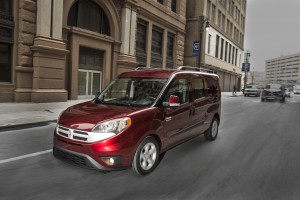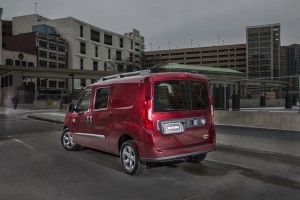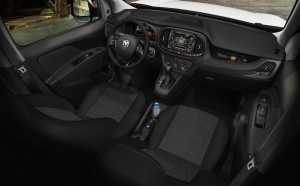
The Ram ProMaster City is smaller than the traditional body-on-frame vans employed by variety of users in the U.S., but easier to maneuver.
Until recently, the commercial van business was a quiet, dusty corner of the automobile world where old-school vehicles managed to help keep the wheels of the economy moving on their aging springs and axles.
However, the segment is undergoing something of a revolution as American businesses, large and small, turn to smaller, Euro-style vans ranging from the Mercedes-Benz Sprinter to Ford’s Transit Connect to carry tools and cargo through increasingly crowded urban centers around the United States.
Fiat Chrysler Automobiles won’t be left out of the growing market as it is bringing the ProMaster City, which is based on the successful Fiat Doblò, a two-time International Van of the Year winner, winner with more than 1.3 million units sold, to the U.S. market.
The manufacturers expect to sell about 385,000 units in 2014 and another 410,000 units in 2015 in 2015. Roughly 25% of the vans will be the small vans such as the Pro Master City, which is expected to account for about 25% of all commercial van sales in the U.S.

The Ram ProMaster City is often a better fit for caterers, florists and other kinds of service business that don’t require a full-size van.
“The average commercial van in the U.S. is 11 years old and is wearing out,” noted David Elshoff, spokesman for FCA Group’s Ram unit, which now markets European-built ProMaster vans in the U.S.
In addition, many of the vans on the road were older one-size-fits-all body on frame vans built by GM, Ford and Chrysler. Now businesses have an opportunity to right size their fleets and make them more efficient, Elshoff noted. “Cost of ownership is important,” he said.
The ProMaster City is smaller than the traditional body-on-frame vans employed by variety of users in the U.S. That said, it’s also easier to maneuver and to park in the increasingly crowded urban centers across the U.S., according to Elshoff and other FCA representatives.
Business owners and operators of commercial fleets are moving to smaller vehicles because they are more fuel-efficient. They are also a better fit for caterers, florists and other kinds of service business that don’t require a full-size van.
The ProMaster City, which is now being shipped to FCA dealers around the U.S., is also quieter, easier to drive and more nimble than a conventional vans with a high center of gravity that challenged the available stability control systems.
The Ram ProMaster City, however, incorporates familiar Ram Truck design elements, along with the sliding doors, and offer features, systems and powertrains preferred by North American customers.

The front passenger compartment of the ProMaster is nicer than that of the average commercial van, including having two cup holders.
The maneuverability, ease and precision of the steering and well-tuned suspension all came into play during the short test drive of the ProMaster City, which took us through urban streets and freeways and an urban slalom that FCA had set up to show the vehicle to its best advantage. The overall impression was that the ProMaster City actually drives much like an automobile.
The suspension has been specifically tuned for American streets and gives the vehicle a nice solid feel out on the road.
On the inside, the van is quiet, surprisingly quiet, considering that the rear of the vehicle was unfinished except for the tie down points so it could serve as a cargo carrier. The vans were designed specifically to ber outfitted with shelving or bins. Chrysler also plans to offer a passenger-carry version of ProMaster City with the addition of a second row of bench style seats that fit nicely with vehicle’s utilitarian styling.
FCA has equipped the ProMaster City with the 2.4-liter Tiger Shark engine and the company’s sophisticated nine-speed transmission. The result is a relatively quiet powertrain that produces 174 horsepower and 178 foot-pounds of torque. The combination produces ample power out on the highway or to get around obstacles in city driving.
(Ford Transit helps conquer commercial truck world. For more, Click Here.)
The front passenger compartment, including the door panels, is silenced thanks to acoustic treatments and a standard carpeted floor.
(Click Here for details about the debut of Nissan’s Taxi of Tomorrow.)
The climate control and interior lighting are effective and visibility is outstanding for a small van. The elliptical main cluster is located under a prominent antiglare dome and allows information to be read easily and immediately under all lighting conditions.
The orange backlighting allows the pupil to focus more quickly when changing from the dark road to the brightly-lit dashboard. From left to right the display features coolant temperature, speedometer, tachometer and fuel gauges. The bottom includes a digital display of the trip computer with clock, odometer or trip counter.
(To see more about the impact of falling gas prices, Click Here.)
The easy-to-use automatic transmission shift lever is located on the elevated center console. As the console drops down toward the rear, a smaller console rises between the front seats and contains two cup holders and two 12-volt power outlets within easy reach.
“Operators of a new Ram ProMaster City will need to stay focused on daily tasks, so we want the cabin to be a place of comfort, convenience and functionality,” said Klaus Busse, head of Interior Design — Chrysler Group LLC. “Without question, the goal is to create an interior for the person who will spend many hours at the wheel and/or working in and out of the cargo area.”

It should be obvious that the Euro vans are typically narrower and taller than U.S. vans – primarily due to narrow roads in many parts of Europe. A narrow van in and of itself is not an asset in the U.S. nor is a higher center of gravity from a tall van. Improved drivability would be the primary asset for these vehicles in the U.S.
A conventional U.S. commercial van is still preferred for many businesses. The Euro vans may be more suited for niche applications. One Fiat experience may be more than enough for a lot of U.S. consumers?
Another difference between American vans and Euro vans is that Euro vans are exceedingly ugly. Now Chryco has its own ugly van that is just as ugly as the ford, Nissan and Daimler vans. Bring back the B Van, a “manly” vehicle.